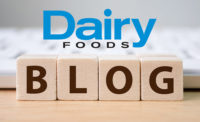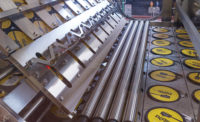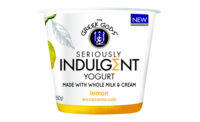Koel Thomae and Rob Graves hit the yogurt market at the right time. In 2009, they founded noosa yoghurt in Bellvue, Colo. (The company refers to itself in the lowercase.) Their creamy, whole milk yogurts flavored with native and exotic fruits have been a hit with consumers and retailers alike.
At the beginning of this decade, Fage, followed by Chobani, set off a chain reaction in the cultured dairy aisle with their Greek yogurts. Traditional cup-set yogurts were overshadowed by the thicker, higher-protein and more tart Greek varieties. The category also saw dairy processors promoting cream-top and organic versions. Yogurt brands added geographical modifiers, including Icelandic, Vietnamese, Australian, Swiss and German, thus creating a United Nations in the dairy aisle.
Noosa traces its roots to Australia, but Thomae doesn’t consider it to be an “Australian” yogurt. Nevertheless, the tag came in handy during the early brand-building days. After all, every product needs a story.
Thomae grew up eating yogurt in Australia. After graduating from college, she did her “walk about” in the United States and landed a job in Boulder, Colo., with Izze Beverage Co. On a visit home, she tasted products from Queensland Yoghurt. Noosa is named after a resort town in Queensland of the same name.
“It wasn’t like anything that I had grown up with. It wasn’t like anything that I could get in the U.S.,” she said.
She had to have it. Thomae returned to Colorado with the rights to license the recipe. Then she had to find someone to make it. Enter dairy farmer and dairy processor Rob Graves, the owner of Morning Fresh. Thomae left Izze and she and Graves together founded their yogurt company in the little Rocky Mountain town of Bellvue, near Fort Collins.
“So many people were coming back into the yogurt aisle, and really getting more adventurous with trying new things,” she said. “We were very fortunate to have this sort of amazing groundswell of support from our local community. Colorado is known for being a very health-oriented, very active community. People here are all about living life to the fullest. And that means eating delicious food and finding that balance in their diets.”
While Thomae still considers noosa to be a start-up company seven years after its founding, it did get large enough to be noticed and acquired by Advent International in November 2014. Investment by the private equity firm ($34 billion in assets) has given the yogurt maker funds to expand the plant. It also allowed noosa to buy the yogurt recipe outright from its Australian partner. Today, the CEO is Frank Higgins, whose resume includes Nestle. Graves and Thomae continue to own part of the company they founded.
In a statement announcing the acquisition, Advent Managing Director Jeff Case said “we see significant potential to further develop the business by extending its product line, increasing production capacity and expanding geographically.”
Getting started
“Connecting with Rob was pure luck. I joked with Rob in the early days. ‘You know that one day noosa’s going to overtake your dairy. And he was like, “Oh, ha ha! You’re funny!’”
Replied Graves, “Yeah, and three years later . . .” He’s still waiting to expand his fluid milk processing plant.
Thomae and Graves banter easily. He’s more of the laid-back, methodical partner who figures out how to get things done. Thomae moves a mile a minute, bucking tradition and rejecting reasons why something won’t work.
The Morning Fresh fluid plant bottles white, chocolate and root beer-flavored milk. Graves sells the milk in glass bottles to groceries, restaurants and home delivery customers. The fourth-generation dairy farmer said, “We’re just a traditional dairy. We’ve got the farms, grow our own feed, grow our own cattle.”
Before he co-founded noosa, Graves never made yogurt. But over the years he had tried his hand at cottage cheese, cream cheese and blue cheese.
The whole story
Noosa’s original target market was outdoor-oriented, active consumers. A whole-milk food was not a deal breaker to these buyers. As industry research concludes that whole-fat dairy products provide satiety and other meritorious benefits from dairy fat, that only helps noosa.
The yogurt is characterized by whole milk, a creamy texture, a wide variety of flavors, see-through packaging and package size. Noosa packs its yogurt into 8-ounce cups (versus 5.3 ounces for most other brands). It also offers 4-ounce cups sold in four-packs and select flavors in 24-ounce tubs.
Thomae said she believed that clear package was vital. She wanted consumers to see the colorful fruits and honey packaged inside. The cups were only available in an 8-ounce size. Since the founders did not have the funds to buy custom molds, they took what they could get.
“When you’re a scrappy startup, you don’t have a lot of money,” she said. “We really wanted the product to speak for itself. We wanted it to be simple and highlight the freshness of the ingredients and product. So we wanted that clear container.”
Dairy buyers in supermarket channels, on the other hand, weren’t so sure. There was a lot of “consternation” around that, Thomae said. But Graves said, “It was absolutely the right decision because we were different.”
Eventually, “I think we just wore them down,” Thomae said. “They were like okay, it’s only four SKUs.”
Noosa’s four original flavors were honey, blueberry, raspberry and mango. Plain came later, along with other fruity and savory flavors and combinations, including passion fruit. Graves said the taste test clinched the deal and dispelled any doubts dairy buyers might have.
Noosa spends a lot of time talking to customers and consumers. Dairy managers are just as important as dairy buyers, Thomae said. By speaking with those who stock the dairy case, noosa found out which packages are easy to stock and which pose problems. Noosa’s flat containers are easy to stack, and that scores points with dairy managers who can become “brand advocates to other customers,” Thomae said.
Graves had a relationship with Whole Foods from his fluid milk business. The grocer was asking Graves to expand his product line. When they asked what other foods he had, he was ready with an answer: “yogurt.” It launched in 2010. That spring, Thomae also took the yogurts to farmers’ markets in Colorado. Sampling helped to build word-of-mouth about this new product.
Graves and Thomae had the recipes and the flavors, but they credit their retail partners for their success.
“We had some really visionary buyers,” Thomae said. “I think about Safeway and Target. They embraced [noosa’s concept]. They were like, ‘This is disruptive. This is unlike what anyone else is doing. And you’re absolutely delivering on the product quality and uniqueness of this yogurt.’”
Speaking about Target, Thomae said, “They’re definitely visionary and smart about working with emerging brands. They want to make sure that [products] resonate with their guests.”
That 8-ounce cup, billed as a single serving, became noosa’s signature, Thomae said. She does point out that the contents don’t have to be consumed at one sitting. The resealable lid will keep the yogurt fresh.
Thomae said that her experiences at Izze, another entrepreneurial food company, helped her in starting noosa. She began as operations coordinator and left as operations manager. At Izze, she gained experience in procurement and supply chain.
“I think it gave me actually a really good grounding to come into a business more from an operational versus sort of a sales and marketing bent. I realized you can go in and win a sale. But if you don’t actually fulfill that sale, often you only get one chance. So it’s not about just delivering an amazing product, it’s about delivering great service. Your retailer is your customer just as much as your consumer,” she said.
Noosa yoghurt was tested on that point after exhibiting at Natural Products Expo West in Anaheim, Calif. Target told her it wanted to carry the food in its Super Target stores. She said her immediate reaction was “Yes” and then she said, “Can I just get back to you on that?” She called Graves in Bellvue and asked, “Can we make enough yogurt?”
“I remember that phone call,” Graves said. “A little scary.”
The success had started a snowball effect. Retailers and consumers were asking for noosa. He told Thomae they could make enough yogurt for Target, but she had to stop selling to other retailers for a while.
At the time, the company had ample milk supply courtesy of Graves’ dairy farm. (Today, Graves sources additional milk from local farmers in the Dairy Farmers of America cooperative.) The limiting factor then was manufacturing capacity. Though he had been expanding his plant, Graves wasn’t that far removed from the days of making 200-gallon batches and culturing it in 5-gallon buckets. In those early days, Graves was even cooking fruit purees on his stovetop at home.
“When Target called, we were just ready to build what we called plant 3.0. So it was a big deal, it went from 3.0 to 3.5. And just recently, not quite eight months, we’ve been at plant 4.0, which is our current capacity. [We kept] adding on and learning from our previous plants how to make things better.”
Flavors are developed internally, not from consumer focus groups. Strawberry-rhubarb, for instance, came from Graves’ grandmother. Consumers in the Midwest know the combination from pies, Graves said, but it is unusual in a yogurt. The company’s first seasonal flavor was pumpkin, and it was made for Target. It was the retailer’s No. 1 SKU, Thomae said, and Target has kept it as a year-round offering.
Noosa is the No. 1 yogurt brand in Colorado, surpassing the larger national brands, according to the sales data from IRI. The brand has earned the highest net promoter score – a measure of how likely one is to recommend noosa to a friend – of any other yogurt brand, according to a McKinsey survey done in November 2015.
The Blackberry Serrano flavor is available only in Colorado for now. Eventually, it will be sold nationally. The serrano chili delivers a definite bite, but the yogurt mitigates some of the heat from the pepper. Thomae warned that consumers who spoon out the serrano ribbon and don’t mix it into the white mass might be in for surprise.
The Blackberry Serrano is one of four new flavors in 2016. The others are key lime, blood orange and salted caramel. This last flavor is sold in four-ounce four-packs. The company also brought back passion fruit (Thomae’s favorite) in four-ounce four-packs. Vanilla, raspberry and strawberry rhubarb also are sold in four-packs.
Noosa’s relatively small size is an advantage. Small companies can be more nimble and take more chances than their larger rivals. Large companies tend to lose patience with new products and discontinue them if they don’t immediately meet sales projections.
What’s next for noosa? Line extensions, like a drinkable yogurt, are obvious possibilities. But Graves and Thomae say nothing will happen until a product is absolutely perfect. Give them credit for being patient. They have been working on a chocolate yogurt for nearly six years.
“We’re unwilling to launch anything that is not up to that noosa-esqsue standard,” she said. Graves said simply, “Usually, the criteria that we work off is that it has to have that ‘wow’ factor.”
Advent International’s financial backing and management experience is helping noosa to become a better-run company. Its other investments are as varied as apparel maker lululemon athletica, food retailer The Coffee Bean & Tea Leaf and bedding manufacturer Serta Simmons. The new owners have brought changes to noosa, among them formalizing key performance indicators.
Thomae noted, “If anything, I think they’ve pushed us on our commitment to quality.”
Noosa has come a long way from the days of cooking fruit prep on a home stove, making 5-gallon pails of yogurt and hand-taping cartons. Today, the company has 5,000 customers representing 25,000 stores. That’s a lot of exposure for the brand.
Yogurt processors point to the high per-capita consumption of yogurt in Europe. Americans have a long way to go to close the gap. But if more consumers come to the yogurt aisle, there will be plenty of business for noosa and its rivals.
Photos byPaul Wedlake Photography








